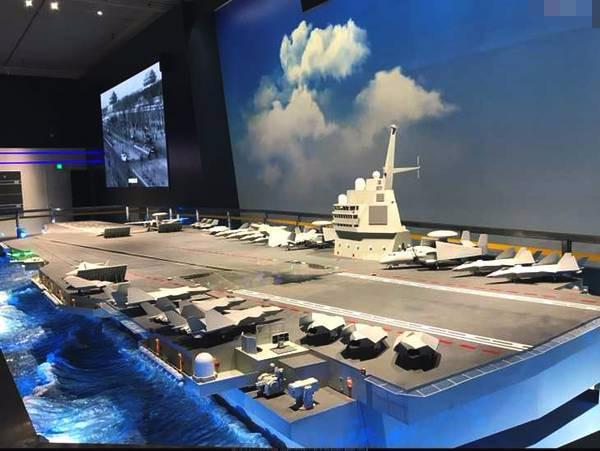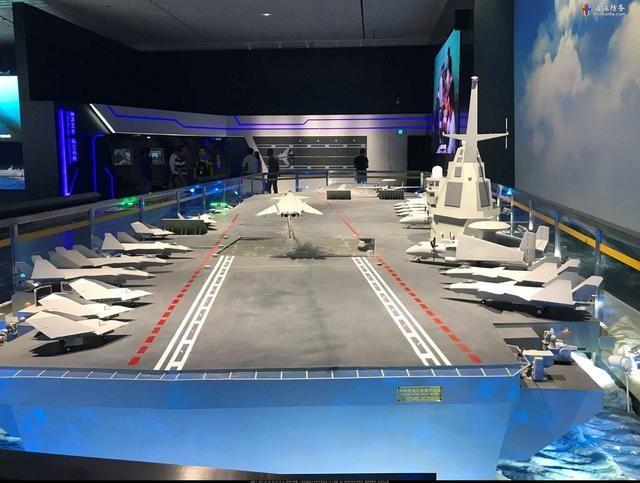

.
西方軍事專家分析中國首艘核子動力航空母艦CVN.想像CG圖.
CHINA NAVY CVN-19.
CHINA star construction up first CVN -20?China plans to build nuclear-powered aircraft carrier amid rapid navy expansion .China is developing technologies to build a nuclear-powered aircraft carrier, state media reported on Wednesday, as Beijing pushes forward with an ambitious military modernisation programme.
Chinese President Xi Jinping pledged in October last year to turn Chinas military into a world-class fighting force by 2050, and has made new technology development a key policy plank, investing in stealth fighters, aircraft carriers and missiles.
State-owned China Shipbuilding Industry Corporation (CSIC), the countrys largest naval vessel manufacturer, revealed on Tuesday the ambition in a list of technical developments the company hopes to achieve as part of weaponry upgrades for the Chinese navy by 2025, according to the state-backed Global Times.
The announcement by CSIC appears to have been subsequently edited on the companys website to remove the mention of nuclear-powered vessels, but it remains widely available on the Chinese internet.
"We must...speed up key breakthroughs such as the realisation of nuclear-powered aircraft carriers, new-style nuclear submarines, quiet submarines, and unmanned intelligent underwater defence systems," the original document said, according to the Global Times
根據以色列及俄羅斯情報顯示出,傳聞中國第三艘國產004型航母已經就在大連造船廠開工建造?
中國海軍能否在2025年之前成為全球第三個裝備核動力航母的國家,004.型航母建造的進度是相當的關鍵。不過在外媒看來,即使中國海軍裝備了一艘核動力航母,只能說與美軍的差距略有縮小,並非是大規模的縮小,因為美軍已經裝備了11艘核動力航母,等到中國004型航母服役的時候,美國核動力航母數量或許已經達到了14艘,而且美軍還擁有長達半個世紀核動力航母的使用經驗,這一點中國海軍即使發展再快也很難追趕。
國際軍事戰略家分析認為,中國海軍此時此刻正在渤海舉行,長達60天的時兵實彈軍事演習,極有可能保護及保密,CVN-20.即Type 004的建造工程因為美國情報船已經接近東海海域及黃海海域,企圖蒐集相關資訊,中國第一艘核子動力航空母艦的建造工程有關資訊,同時也就是說 Type 096SSBN.戰略核潛艦,試射JL-3.巨浪3型潛射彈道飛彈有關?
國際軍事戰略家分析認為,中國海軍將在2025年時期,迎接核子動力航空母艦服役,屆時全世界刮目相看,中國海軍實力強勢崛起,是真實的.
China navy 095SSN.
CHINA TYPE 096 SSBN.will be lanuch JL-3.submarine-launched ballistic missile.SLBM.
The Chinese aircraft carrier programme is the development, production and operation of aircraft carriers by China, primarily driven by the Peoples Liberation Army Navy (PLAN). China has had ambitions to operate aircraft carriers since the 1970s, but at that time had never owned or operated an aircraft carrier before. Since 1985, China has acquired four retired aircraft carriers for study: the Australian HMAS Melbourne and the ex-Soviet carriers Minsk, Kiev and Varyag. The Varyag later underwent an extensive refit to be converted into the Liaoning, Chinas first operational aircraft carrier, which also served as a basis for Chinas subsequent design iterations. As of 2018[update], the PLAN has two combat-ready aircraft carriers, the Liaoning and Shandong, with the third under construction] It is projected that China may possess five or six aircraft carriers by the 2030s.
China Naval Modernization: Implications for U.S. Navy Capabilities—Background and Issues for Congress.
In an era of renewed great power competition, China’s military modernization effort, including its naval modernization effort, has become the top focus of U.S. defense planning and budgeting. China’s navy, which China has been steadily modernizing for more than 25 years, since the early to mid-1990s, has become a formidable military force within China’s near-seas region, and it is conducting a growing number of operations in more-distant waters, including the broader waters of the Western Pacific, the Indian Ocean, and waters around Europe. China’s navy is viewed as posing a major challenge to the U.S. Navy’s ability to achieve and maintain wartime control of blue-water ocean areas in the Western Pacific—the first such challenge the U.S. Navy has faced since the end of the Cold War—and forms a key element of a Chinese challenge to the long-standing status of the United States as the leading military power in the Western Pacific.
China’s naval modernization effort encompasses a wide array of platform and weapon acquisition programs, including anti-ship ballistic missiles (ASBMs), anti-ship cruise missiles (ASCMs), submarines, surface ships, aircraft, unmanned vehicles (UVs), and supporting C4ISR (command and control, communications, computers, intelligence, surveillance, and reconnaissance) systems. China’s naval modernization effort also includes improvements in maintenance and logistics, doctrine, personnel quality, education and training, and exercises.
China’s military modernization effort, including its naval modernization effort, is assessed as being aimed at developing capabilities for addressing the situation with Taiwan militarily, if need be; for achieving a greater degree of control or domination over China’s near-seas region, particularly the South China Sea; for enforcing China’s view that it has the right to regulate foreign military activities in its 200-mile maritime exclusive economic zone (EEZ); for defending China’s commercial sea lines of communication (SLOCs), particularly those linking China to the Persian Gulf; for displacing U.S. influence in the Western Pacific; and for asserting China’s status as the leading regional power and a major world power.
Consistent with these goals, observers believe China wants its navy to be capable of acting as part of a Chinese anti-access/area-denial (A2/AD) force—a force that can deter U.S. intervention in a conflict in China’s near-seas region over Taiwan or some other issue, or failing that, delay the arrival or reduce the effectiveness of intervening U.S. forces. Additional missions for China’s navy include conducting maritime security (including antipiracy) operations, evacuating Chinese nationals from foreign countries when necessary, and conducting humanitarian assistance/disaste response (HA/DR) operations.
The U.S. Navy in recent years has taken a number of actions to counter China’s naval modernization effort. Among other things, the U.S. Navy has shifted a greater percentage of its fleet to the Pacific; assigned its most-capable new ships and aircraft and its best personnel to the Pacific; maintained or increased general presence operations, training and developmental exercises, and engagement and cooperation with allied and other navies in the Indo-Pacific; increased the planned future size of the Navy; initiated, increased, or accelerated numerous programs for developing new military technologies and acquiring new ships, aircraft, unmanned vehicles, and weapons; begun development of new operational concepts (i.e., new ways to employ Navy and Marine Corps forces) for countering Chinese maritime A2/AD forces; and signaled that the Navy in coming years will shift to a more-distributed fleet architecture that will feature a smaller portion of larger ships, a larger portion of smaller ships, and a substantially greater use of unmanned vehicles. The issue for Congress is whether the U.S. Navy is responding appropriately to China’s naval modernization effort.


 .
.












